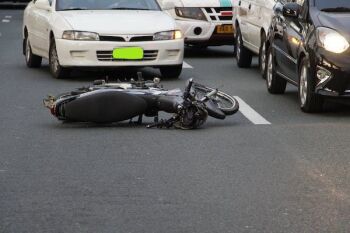| | Biker News - Regularly updated
Category: Safety & Compensation
-
Nearly half of all Traumatic Brain Injuries (TBIs) are believed to be caused by road traffic accidents (RTAs).
With RTAs being the most common cause of TBI in the young. But many of those injured are unaware they may have a case for support and compensation.
What can be done to ensure injured parties get the support they need?
According to the best estimates available, some 1.4 million people attend A&E at hospitals every year with a Head Injury, and 160,000 of those then go on to be admitted to hospital. However, a significant proportion of people who sustain a TBI or Head Injury in a road traffic accident are thought to be missing out on compensation to which they are entitled, simply because they do not think they have a case.
The casualties slipping through the net include those who are partly at fault for the accident in which they were involved, or who are related to the person at fault. Others who mistakenly think they cannot make a claim, are those injured by a driver not subsequently prosecuted by the police, or who were in a crash with an uninsured driver or unknown driver. The injured party in all these scenarios could still be entitled to compensation to help them rebuild their lives.
According to the RAC Foundation, by September last year there were 40.8 million licensed vehicles on the UK’s roads, including 33.2 million cars, 4.1 million vans, 1.5 million motorcyles, 500,000 HGVs, and 150,000 buses and coaches. On top of this there are also an unknown number of bicycles and, of course, pedestrians. With all these different users sharing our crowded roads, it is therefore unsurprising that accidents happen.
In fact, someone is killed or seriously injured on UK roads every 16 minutes, and there are thought to be several reasons why road traffic accident (RTA) rates remain consistently high:
· The driver or rider failing to look properly (37%)
· The driver or rider failing to judge the other person’s path or speed (19%)
· The driver or rider acting recklessly, hurried driving or speeding (16%)
· A poor turn or manoeuvre (12%)
· Loss of control (11%)
And whilst there have been considerable advances in vehicle technology, the likelihood of head injuries at speeds in excess of 10 mph remains high.
A TBI is usually caused by an impact to the head. This external force can cause a focal injury to the brain. An impact to the head, or if the head is violently shaken without any impact, can also cause what is known as an acceleration/deceleration injury. This is where there is a sudden violent movement of the head causing the brain to move and rotate inside the skull. These can cause bruising (contusion) to the brain and trauma to the blood vessels causing bleeding (hematoma or haemorrhage). Contusions and Bleeds will usually be seen on head scans; however, an acceleration/deceleration injury can cause the shearing or stretching of the nerve fibres (axons) inside the brain which are microscopic and unlikely to be visible on a brain scan.
Concussions and those labelled a ‘mild head injury’ are also unlikely to be seen on any scan but can cause ongoing symptoms for some which can have significant consequences– see our blog on concussion.
The risk of TBI also depends on road user type (i.e. car, motorbike, bicycle or pedestrian), the speed of impact and the direction of impact. The higher the speed, the greater the impact on the skull and the brain. Research has shown that the risk of brain injury triples when the impact velocity is doubled.
Brain injury is also more likely in cars involved in side impacts, or where the change of speed is greater, like during a head-on collision. It is also more likely in vulnerable road users, especially where no head protection is worn, with pedestrians and cyclists six times more likely than car occupants to suffer moderate to severe brain injury on the roads.
The Office for National Statistics also gives us the following information relating to non-car road traffic accidents:
· Pedestrians – there are more than 700 pedestrian deaths, and 7,000 injuries annually
· Motorbikes – there are more than 600 motorbike deaths and almost 7,000 injuries annually
· Cycling – there are approximately 120 deaths and more than 2,000 injuries annually
Sadly, suffering from a TBI can be life changing, even if initially considered to be on the ‘mild’ end of the scale. It is therefore crucial to seek out specialist legal advice as soon as possible, even if you fear you may not have a case for compensation.
At Coulthursts, we are unique as a law firm in that we provide a joint legal and rehabilitation approach. We can will pay for and coordinate treatment and rehabilitation at the earliest opportunity, to give our clients the best chance of making the best and quickest recovery from their brain injury. At the same time, we deal with the legal claim and fight to obtain the best possible compensation. We also pride ourselves in providing support to the whole family and not just the injured individual.
Please do not hesitate to contact Coulthursts to discuss your accident at no cost or obligation.
For Coulthursts terms of use and disclaimer see this link:
https://coulthursts.co.uk/legal-terms-of-use/
coulthursts.co.uk

article supplied
-
Tips and Legal Guidance
As the warm embrace of summer envelops us, the allure of hitting the open road on a motorbike beckons to many enthusiasts. However, with the joys of cruising under the sun comes a sobering reality: an increase in motorbike accidents during the summer months. Understanding the reasons behind this spike and knowing what to do in the unfortunate event of a crash can make all the difference.
Here's a closer look at the statistics, precautions, and legal recourse available, including insights from Tylers Solicitors.
The Surge in Summer Motorbike Accidents:
Statistically, the summer months see a noticeable uptick in motorbike accidents. There are several factors contributing to this trend:
Increased Traffic: With better weather, more vehicles, including motorbikes, populate the roads. This congestion heightens the risk of accidents due to the sheer volume of vehicles sharing the road.
Visibility Challenges: While summer brings longer daylight hours, it also introduces glare from the sun, which can impede visibility for both motorcyclists and other motorists. This decreased visibility raises the likelihood of collisions.
Inexperienced Riders: Summer often attracts novice riders eager to experience the thrill of motorcycling. Unfortunately, inexperienced riders may be more prone to accidents due to a lack of skill or proper training.
Road Conditions: Summer weather can also impact road surfaces. Factors such as increased oil slicks from vehicles, loose gravel, or uneven pavement can create hazardous conditions for motorcyclists.
What to Do in the Event of a Crash:
Despite precautions, accidents can still occur. Knowing how to respond can mitigate the aftermath's impact.
Here are the essential steps to take if you're involved in a motorbike accident:
Assess Injuries: Prioritise your safety and that of others involved. Check for injuries and seek medical attention immediately if needed.
Report the Accident: Contact law enforcement to report the accident. A police report can serve as crucial documentation for insurance claims and legal proceedings.
Gather Information: Collect pertinent details such as the other party's contact and insurance information, as well as eyewitness accounts and photographic evidence of the scene.
Seek Legal Guidance: Consult with a reputable solicitor specialising in motorbike accidents claims like Tylers Solicitors. They can offer expert advice on navigating the legal complexities, ensuring your rights are protected and you receive fair compensation for damages incurred.
Tylers Solicitors: A Trusted Partner in Motorbike Accident Claims:
Tylers Solicitors understands the unique challenges faced by motorbike accident victims. With years of experience in handling such cases, they offer compassionate support and robust legal representation.
Here's how they can assist:
Expertise: Tylers Solicitors boasts a team of skilled professionals well-versed in motorbike accident law. They leverage their expertise to advocate for clients' rights and pursue maximum compensation for injuries and damages.
Personalised Approach: Recognizing that every case is unique, Tylers Solicitors provides personalised attention to each client. They take the time to understand the specific circumstances surrounding the accident, tailoring their approach to achieve optimal outcomes.
Comprehensive Support: From guiding clients through the claims process to representing them in negotiations or litigation, Tylers Solicitors offers comprehensive support at every stage. They strive to alleviate the burden on clients, allowing them to focus on recovery.
Transparent Communication: Tylers Solicitors prioritises transparent communication, keeping clients informed and empowered throughout the legal proceedings. They are readily accessible to address any questions or concerns, fostering trust and confidence in their representation.
Conclusion:
Summer beckons motorbike enthusiasts to embrace the thrill of the open road, but it also brings heightened risks of accidents. Understanding the contributing factors and taking precautions can help mitigate these risks. In the unfortunate event of a crash, knowing what steps to take and seeking legal guidance from trusted professionals like Tylers Solicitors can ensure your rights are protected and you receive the compensation you deserve. Stay safe, ride responsibly, and remember that help is always available when you need it most.
Article from Tylers Solicitors
www.tylerssolicitors.co.uk

-
by Chris Macwilliam, Partner & Head of Litigation, Clough & Willis Solicitors
Motorcycle riders are among the most vulnerable road users and, when accidents occur, the results can be severe. When you are involved in an accident, there are several procedures you should follow in the immediate aftermath to maximise your chances at recovery. If the accident was not your fault, you may also be entitled to compensation that can not only account for your pain and suffering, but act to minimise any financial losses.
Compensation can help to make your recovery more comfortable, account for the costs of any damaged equipment and ensure you receive the best available treatment. Here, the team at Clough & Willis Solicitors explains the steps you should take if you have been injured in a road traffic accident to support your recovery and give yourself the best chance of securing compensation.
Seek medical attention
The first step you should take following a road traffic accident is to seek medical attention. Naturally, you should seek emergency care if you have been seriously injured, but this is important even if you do not feel that you have been injured, especially if you were riding a motorbike. Some injuries are hard to detect immediately but can have serious lasting consequences that emerge later, and motorcycle riders are particularly vulnerable to these types of injuries. A doctor will know what to look out for in terms of symptoms based on the nature of your accident, and may be able to diagnose and treat conditions that you would otherwise have been unaware of.
The other important reason to consult a medical professional is that your medical records can be used as evidence. Your doctor will make notes about any conditions or injuries they find, and this can be used to show a clear link between your accident and any symptoms that later arise. This can form a fundamental piece of evidence to support a claim, if you decide to pursue compensation for your injuries.
Collect evidence
If you are able, you should collect evidence at the scene of the accident. This usually includes the contact details of any eyewitnesses who saw the accident take place, but may also mean taking photographs and writing down any details you can remember, which can support your account later.
You should take photographs of any elements that may have contributed to the accident (such as evidence of potholes or other poor road conditions) and any vehicles involved. If the accident was not your fault, you may be able to secure compensation not only for your injuries, but also for damage to your vehicle or equipment. As such, you should also document this damage and, if you can, find photographs of your belongings before the accident, which can help to show that the accident was the cause of the damage in question.
This step applies to all road traffic accidents, not only those involving other vehicles. For example, if you are injured when your motorcycle collides with a pothole, you may still be entitled to make a claim. This is because local authorities are responsible for maintaining roads in UK towns and cities, and must ensure that conditions are as safe as possible. Generally, the only preconditions you must meet to make a claim are that you have been injured, and that someone else was responsible for your accident.
The final type of evidence you should gather is receipts for any expenses related to your accident. This includes if you need to pay for private healthcare, any travel arrangements to and from medical appointments, and any lost earnings if you are forced to take time off from work to recover from your injury. With these receipts, you may be able to claim back these costs when making a compensation claim.
Speak to a solicitor Once you have collected as much evidence as you can, speak to an expert personal injury solicitor. They will be able to advise you on whether or not you can claim, and help you to build your case - for example, by collecting witness statements or arranging for independent medical examinations. Where necessary, they can even advise you and help you to secure the best possible treatment for your injury. In most cases, any costs for private medical treatment can be included in your compensation claim, along with any expenses associated with travelling to and from appointments.
A road traffic accident solicitor can begin the process of filing a claim on your behalf. There are strict deadlines associated with personal injury claims - any claims must be initiated within three years of the date of the accident, or they will usually be unable to proceed. If you have been injured in an accident and are unsure what to do, speak to a solicitor today to find out what your next steps should be.
Article by Chris Macwilliam, Partner & Head of Litigation, Clough & Willis Solicitors

-
Riding a motorcycle will offer you a unique experience that feels unlike any other. But although driving a bike comes with the benefits of easier parking, speed and low fuel costs, it also has an increased risk associated with it. Motorcycles are more exposed to accidents, and statistics show that each year, a high number of motorcycle riders are seriously injured or killed. For example, in 2020, the number of motorcyclists killed reached 4,308 in Great Britain.
To stay safe on the road, motorcyclists must act cautiously and always wear protective gear. Here is everything you need to know about motorcycle safety tips.
Get the right gear
You will always have greater freedom on the open road on a motorcycle, but you will also be more exposed to hazards and dangers. If you get into an accident without wearing the right gear, the consequences can be fatal, and you could lose your life. But even if you are never in a collision, simple things might hurt you. For example, you might get hit by a rock on the road, which can have terrible outcomes when you are unprotected.
However, you will have an improved layer of protection if you wear the right gear. Here is the protective gear you need to have while driving your motorcycle.
-
Helmet: Motorcyclists should always wear helmets, as these simple items can really save lives. The risk of death increases if you don't wear a helmet, so don't take any chances and wear a high-quality one that meets the Department of Transportation Safety Standards. Most motorcycle fatalities cause head injuries, so you need to pay attention when you choose your helmet. Your helmet should fit your head properly, have zero slippage, no vision obstructions and cover most of your head. Also, remember that a full-face helmet will offer greater protection, so don't opt for windscreen models.
-
Protective Clothing: Road rash can be a real threat, and the riders who have suffered the pain probably know this aspect. So, getting fortified jackets and riding pants will be better to make the burn less likely to appear.
-
Gloves: Your hands must also be protected while riding your motorcycle, as they can be exposed to all the road elements. So, it will be better to opt for high-quality gloves to keep your hands safe without impeding your dexterity.
Boots: Sturdy boots are also essential to wear, as they ensure protection in case of a crash and protect your skin from the engine's heat.
Maintain your bike in good shape
Many riders leave their bikes in the garage and drive them only on special occasions. However, if you haven't used your motorcycle for some time already, you must check it and ensure it is in good shape before riding it, especially on long drives.
Even if you ride your bike daily, you should still give it a general safety inspection before you head on the road. Keep a list of things you must check, then inspect all the parts. For instance, you must see if your signals and lights are working properly. Then, you will need to check the tire pressure and ensure there are no signs of loose parts or damage anywhere on the bike.
Look twice
This tip might be more suitable for car drivers, but motorcycles should also double-check to ensure they are safe and will not get involved in a car accident. Motorbikes are smaller than cars, making them harder to see. This is why numerous motorcyclists get involved in an accident, as the other drivers don't check enough their environments and miss motorbikes.
Most motorcycle accidents are caused by car drivers. So, even if motorcyclists respected all the legislation and kept their distance, they might still get involved in an accident because of another party's negligence. Although motorbikers can get compensation if they were involved in an accident that didn't happen because of their fault (check out more at www.personalinjuryclaimsuk.org.uk), it is better to double-check to reduce the chances that an accident will happen.
Pay attention to the weather
You also need to check the weather, as adverse weather conditions are one of the reasons why motorcyclists get involved in an accident. So, look at the weather before, especially if you are going on a long road. Motorbikes are not as solid as the other vehicles, so riding in adverse conditions can be more dangerous. Additionally, because there are only two wheels, the traction and visibility during rain are reduced, which can lead to more accidents.
Therefore, you should always check the weather and postpone your trip if there is heavy rain or snow.
Leave sufficient space
One of the most common mistakes drivers make is not leaving enough distance behind the vehicle in the front. This is also important for motorcycles, as even though a bike stops faster than a car, it still needs a fair bit. For example, a motorcyclist driving at 70 mph will need around 245 feet to brake.
Ride sober and alert
It should go without saying that driving under the influence of alcohol and drugs is never a good idea. Also, you shouldn't ride if you are overly stressed or sleep-deprived. The risks in doing so increase for each person, but especially for motorcyclists who need to have a fast reaction time and be at their full faculties.
The other driver participants often ignore motorcyclists, so they need to ride with more attention to ensure they stay safe. But that can't be done when a person is exhausted or tired.
Conclusion
Riding a motorcycle can be an exciting and pleasurable experience. Still, you need to understand the risks you expose yourself to and take precautions to reduce the chances that an accident will happen. Wear your gear, always check your environment, and be alert so that nothing bad will happen to you.

Image source - Image by Freepik
article supplied
-
Motorcyclists are widely known to be at greater risk of accidents and injuries due to their lack of protection compared to car drivers. This is also confirmed by statistics from the Motorcycle Legal Foundation which report that motorcycle accidents have an 80% injury or mortality rate, while car accidents have only 20%.
If you have had a motorcycle accident, in addition to any injuries, you may also be facing mounting medical expenses, rehabilitation costs, and other unexpected financial burdens and losses. To help you with these matters, motorcycle accident lawyers like those at Sadaka Law can help you build a strong personal injury claim and receive the compensation you may be entitled to. In this article, we will outline the legal aspects involved in making a personal injury claim for a motorcycle accident.
Proving Negligence
Success in a personal injury case typically requires proving that the other party's negligence was the cause of the accident and resulting injuries. The burden of proving this will lie with the claimant. This will involve establishing that the elements below apply to their claim:
â— Duty of care: This means proving that the at-fault party had a legal obligation to act in a way that reasonably ensured the safety of the injured motorcyclist.
â— Breach of duty: The at-fault party failed to take reasonable steps to prevent harm by acting negligently or recklessly.
â— Causation: The breach of duty directly caused the accident and the subsequent injuries and losses suffered by the claimant.
â— Damages: The injured party suffered measurable damages for which they can be compensated such as medical expenses, lost earnings, pain and suffering and property damage.
Collecting evidence such as video footage, witness statements and police reports can help claimants establish these points and build a strong personal injury claim.
Mitigation of Damages
While the at-fault party may have a duty of care toward the claimant, the claimant has a duty to mitigate their losses. This legal doctrine prevents an injured party from recovering damages for losses that were reasonably avoidable but which they failed to avoid. The doctrine encourages a fair and just award for damages is made, ensuring that claimants do not profit from their own unreasonable or unwilling actions or omissions.
For example, an injured claimant who fails to heed the advice of their doctor in receiving rehabilitation for their injuries may see a worsening of their condition. The duty to mitigate may reduce the amount of compensation the injured party is eligible to receive for their injuries on the basis that they did not take reasonable steps to minimize their losses.
Mitigation as a Defense

It is worth noting that the duty to mitigate is sometimes raised as a defense by the at-fault party in an attempt to lower the amount of compensation they owe or to avoid liability altogether. In this situation, the burden will be on them to prove that the claimant failed to take reasonable steps to avoid or minimize their losses. It will then be the claimant’s responsibility to refute such claims by putting forward evidence to show they made proactive efforts to mitigate their damages.
The guidance outlined here can help those involved in a motorcycle accident to put together a robust claim for compensation.
article supplied
|







